Every photographer who thinks he/she is a professional and focuses on the wild nature, understands, that the proper lens seriously boosts the efficiency of a camera for wildlife photography. Working in the wildlife you often take pictures at a long distance, so, probably, you need one of the long range camera lenses to get perfect shots. So, the question is, how to select the best lens for your wildlife shooting?
As it is often impossible to come up to the object close enough, you have to select the optics, which will do all the work for you. The article below is going to help you not to get lost in the world of the long range camera lenses.
We have prepared a list of the best lenses showing their advantages and disadvantages, to make your choice easier. Also, you will find the information about the features, which are the most important while making a purchase and some additional tips.
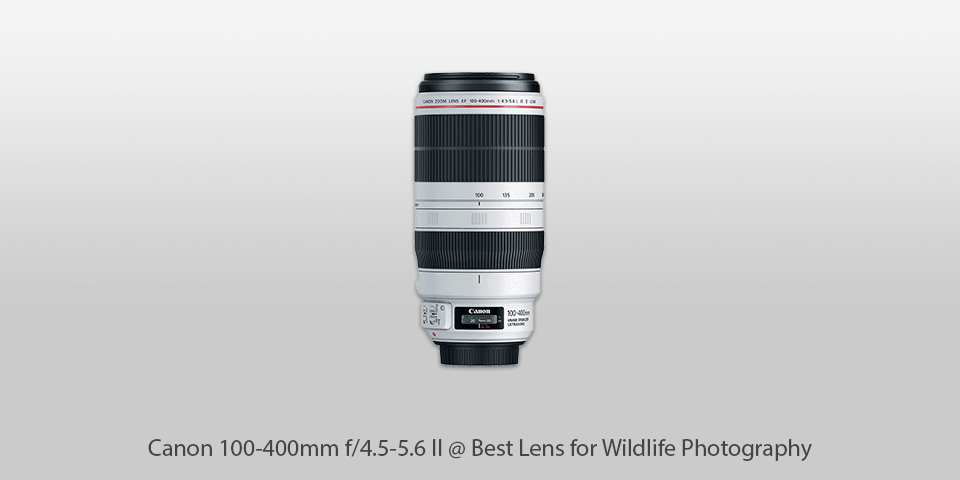
Mount: EF | Diaphragm blades: 9 | Autofocus: yes| Min focus distance: 3.2 feet| Max magnification: 0.31x | Filter thread: 77mm | Dimensions (WxL): 7.6 x 3.7 x 3.7 inches | Weight: 3.46 pounds
⊕ Amazing sharpness, wonderful zoom
⊕ Optical stabilization
⊕ Quick focusing
⊕ 1:3 zooming
⊖ Price above average
⊖ At 100mm may appear a barrel distortion
The Canon 100-400mm f/4.5-5.6 II is considered the best lens for wildlife photography by many professionals all over the world. This lens helps take unbelievable shots, which will be far beyond your expectations, thanks to its great focal length range. If you are an owner of a Canon camera, and you can afford some expenses, don’t hesitate to purchase this universal lens, it’s worth every penny.
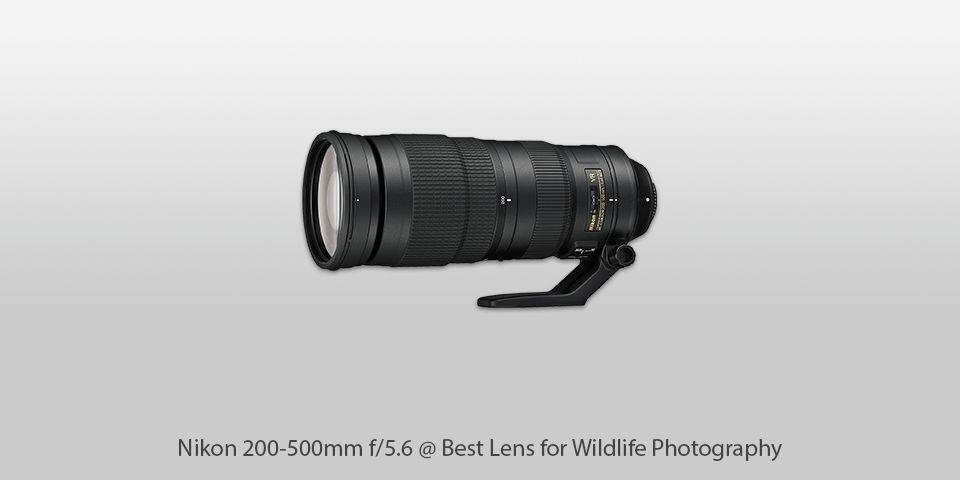
Mount: F | Diaphragm blades: 9 | Autofocus: yes| Min focus distance: 2.2 m | Max magnification: 0.22x | Filter thread: 95 mm | Dimensions (WxL): 108 x 267.5 mm | Weight: 5.07 pounds
⊕ Great sharpness
⊕ Telephoto zoom lens
⊕ Fixed f/5.6 aperture
⊕ Optical stabilization system
⊖ Not the best zooming possible
⊖ Soft edges at 200mm
⊖ Cannot be mounted on older DSLRs
The Nikon 200-500mm f/5.6 is a good lens for outdoor photography, which attracts shooters with its great VR and low price. The maximum aperture of f/5.6 may not satisfy professional sports photographers, but if you are going to shoot in the wild nature, we strongly recommend you to pay attention to this lens.

Mount: EF | Diaphragm blades: 9 | Autofocus: yes| Min focus distance: 2.8 m | Max magnification: 0.2x | Filter thread: 95mm | Dimensions (WxL): 10.2 x 4.1 x 4.1 inches | Weight: 4.3 Pounds
⊕ Perfect telephoto zoom
⊕ Great sharpness
⊕ Kit lens hood and tripod collar
⊕ Fast focusing
⊖ Chromatic aberration
⊖ Some pincushion distortion
⊖ Relatively narrow aperture
⊖ Bulky
⊖ Not fully dust- and moisture protected
The Sigma 150-600mm f/5-6.3 DG OS HSM Contemporary is a great telephoto zoom lens, which guarantees the best image quality at a quite affordable price. Unbelievable telephoto reach, quick focusing, image stabilization system, and the price are the features, that attract a lot of photographers. With this lens, the sharpness is perfect across the entire frame even at the maximum aperture.
Only when you set the telephoto to the maximum, there will be slight edge softness and color fringing. You may also notice some pincushion distortion throughout the zoom range. But these disadvantages are absolutely acceptable, considering other important features of the lens.

Mount: EF| Diaphragm blades: 9 | Autofocus: yes | Min focus distance: 2.7m | Max magnification: 0.2x| Filter thread: 95 mm | Dimensions (WxL): 105.66 x 257.81 mm | Weight:1.95 kg
⊕ Perfect sharpness
⊕ Great stabilization
⊕ Fast AF
⊕ Zoom mechanism may be locked
⊖ Poor quality at wide range
⊖ Teleconverter limits AF
This lens for outdoor photography offers you stable performance, though with some moments to note. When you attach the lens to a full-frame camera, the edge quality may be worse than you expect at the wide and telephoto extremes. You may improve it if you narrow the aperture just a little. Anyway, the lens has a set of very attractive features, like a weather-proof build, a lightweight design, and an irreproachable system of image stabilization. Even considering the issue with edge sharpness, a great overall performance makes the Tamron SP 150-600mm F/5-6.3 Di VC USD G2 a good investment.
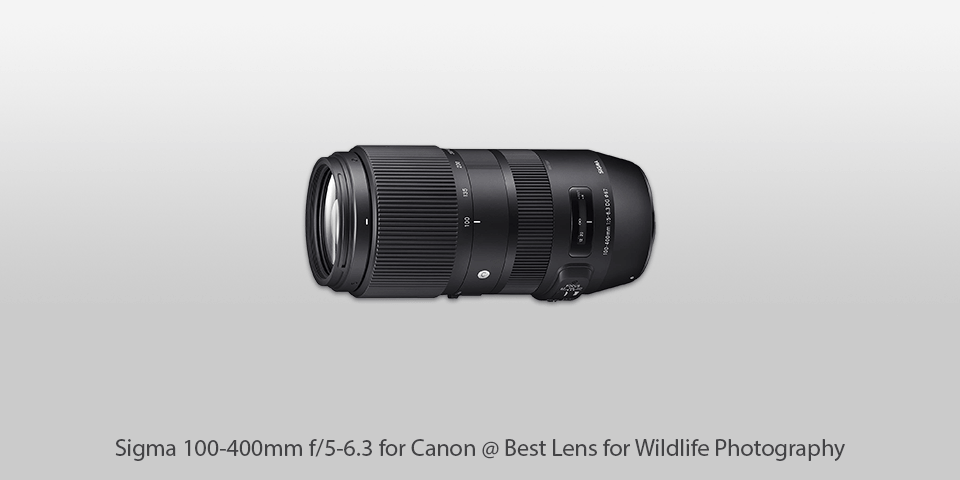
Mount: EF| Diaphragm blades: 9 | Autofocus: yes | Min focus distance: 1.6 m | Max magnification: 0.26x | Filter thread: 67 mm | Dimensions (WxL): 86.4 x 182.3 mm | Weight: 1160 g
⊕ Top-quality images
⊕ Optical stabilization system
⊕ Full-frame coverage
⊕ Multiple systems support
⊖ Poor performance on edges at 100mm
⊖ Max aperture brings vignette
⊖ Distortion
The Sigma 100-400mm f/5-6.3 DG OS HSM Contemporary is a great choice for those, who need a compact and lightweight super zoom lens. The lens offers a strong resolution and perfect long reach for such a low price. Considering the size and the price of the lens, its disadvantages don’t seem too serious. There are competitors with brighter aperture, and you may notice some distortions. If you are looking for a budget lens for wildlife photography, this 100-400mm model is highly recommended, especially if you don’t want a big and heavy zoom.
Also, in a similar price range, we recommend you to pay attention to one more Sigma lens, the 150-600mm f/5-6.3 DG OS HSM Contemporary. This one is more expensive (around $1,100), 4.3 pounds heavier, but its telephoto reach is much longer.
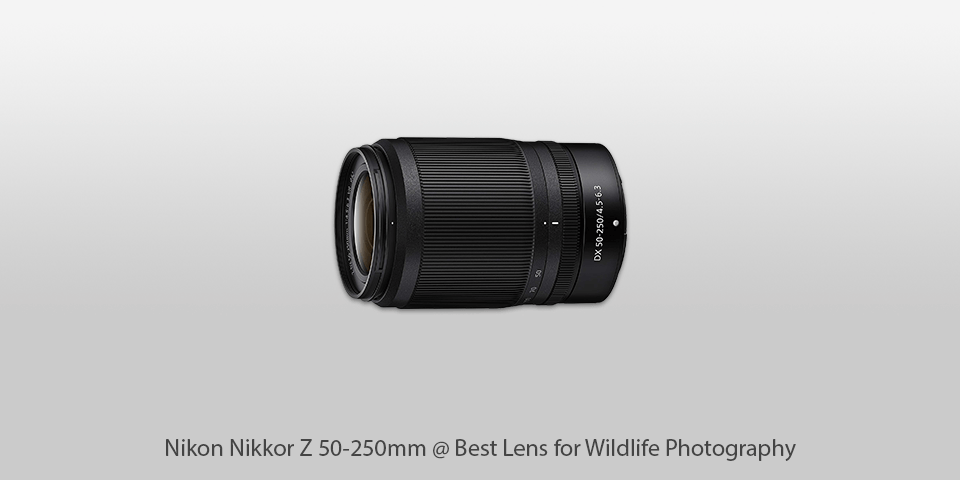
Mount: Z | Diaphragm blades: 9 | Autofocus: yes | Min focus distance: 0,5m | Max magnification: 0.23X | Filter thread: 95 mm | Dimensions (WxL): 4.33 x 2.91 x 2.91 inches | Weight: 14.2 ounces
⊕ OS
⊕ Built-in autofocus
⊖ Not water-tight
⊖ Lens extents while focusing
⊖ Aperture is slow at the wide end
The Nikon Nikkor Z 50-250mm F4.5-6.3 VR is a good lens for long-distance shooting. It has an Auto Focus (AF) Telephoto Zoom with APS-C / DX max sensor coverage. If you mount this lens on an APS-C/DX sensor camera, the FF equivalent focal range will be 75 - 375mm. The lens may seem slow at both ends, as the maximum aperture is 44.5 at 50mm, and f6.3 at 250mm. With a special optical stabilization of the image, you will be able to take sharper pictures at slower shutter speed. Since the lens comes without special protection from weather influence, don’t use it in rain.
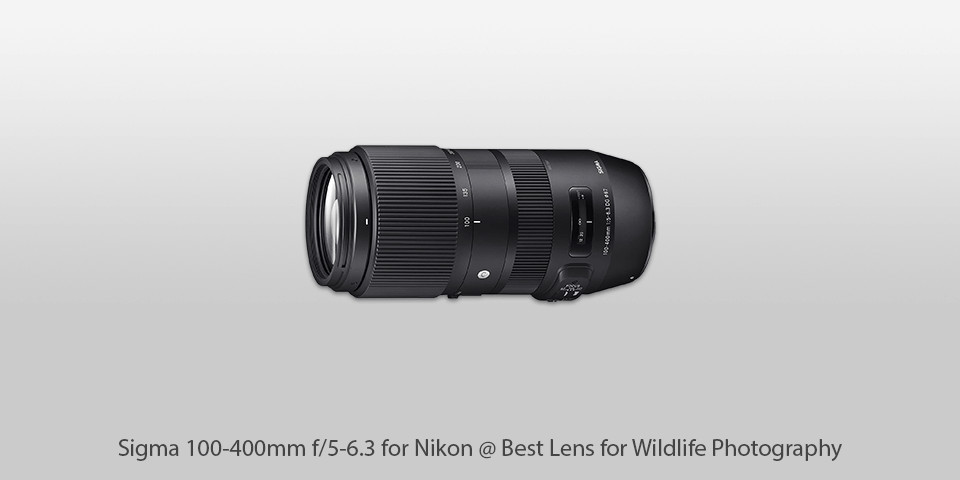
Mount: EF | Diaphragm blades: 9 | Autofocus: yes | Min focus distance: 1.6 m | Max magnification: 0.26x | Filter thread: 67 mm | Dimensions (WxL): 86.4 x 182.3 mm | Weight: 1160 g
⊕ Perfect sharpness
⊕ Low CA
⊕ Minimal distortion
⊕ Low flare
⊖ No weather protection
⊖ Poor edge performance at longer lengths
The Sigma 100-400mm f/5-6.3 is a wonderful telephoto lens, especially for wildlife and sports photographers. This lens offers a perfect combination of features at a reasonable price. Using this lens with the camera, which has high ISO performance, you will get sharp and bright images. The small weight is another advantage of this lens, which is not too compact, but not as large as some competitors.
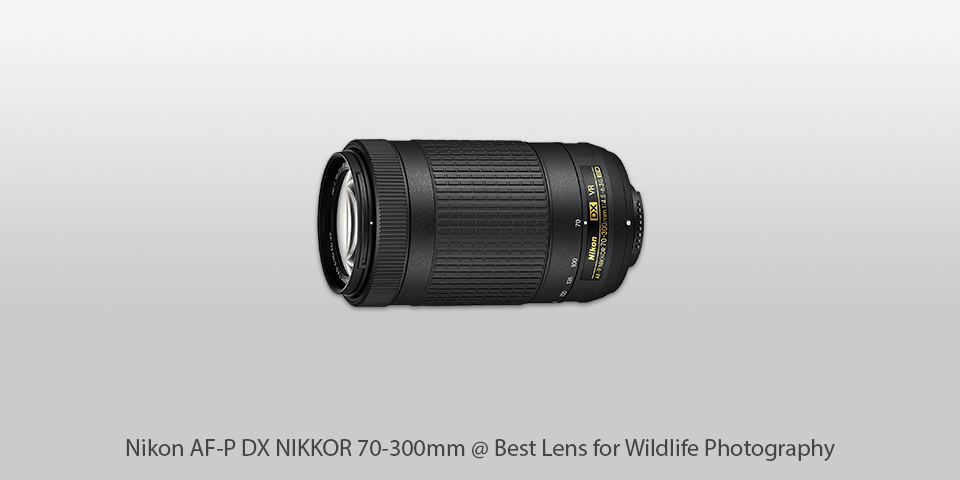
Mount: EF | Diaphragm blades: 9 | Autofocus: yes | Min focus distance: 1.1m | Max magnification: 0.22x| Filter thread: 58mm | Dimensions (WxL): 4.92 x 2.83 x 2.83 inches | Weight: 14.6 ounces
⊕ Compact and lightweight
⊕ Telephoto zoom lens
⊕ Optical image stabilization
⊕ Good-quality image
⊖ Narrow aperture
⊖ Poor manual focus
⊖ Some distortion may appear when you zoom
⊖ Slight vignette
The Nikon AF-P DX Nikkor 70-300mm is a good telephoto lens for those who appreciate high image quality. It produces top-quality images, just remember not to zoom in all the way in order to avoid the distortion, which will appear otherwise.
If you are ready to pay more, you may get a better telephoto zoom lens. We recommend you to have a look at the Sigma 100-400mm F5-6.3 DG OS HSM Contemporary, which is lightweight and compatible with DX and FX cameras. If you are planning to work in low-light conditions, you may choose the Sigma 50-100mm F1.8 DC HSM Art, which is ultra-bright, though compatible with a camera with a DX sensor only.
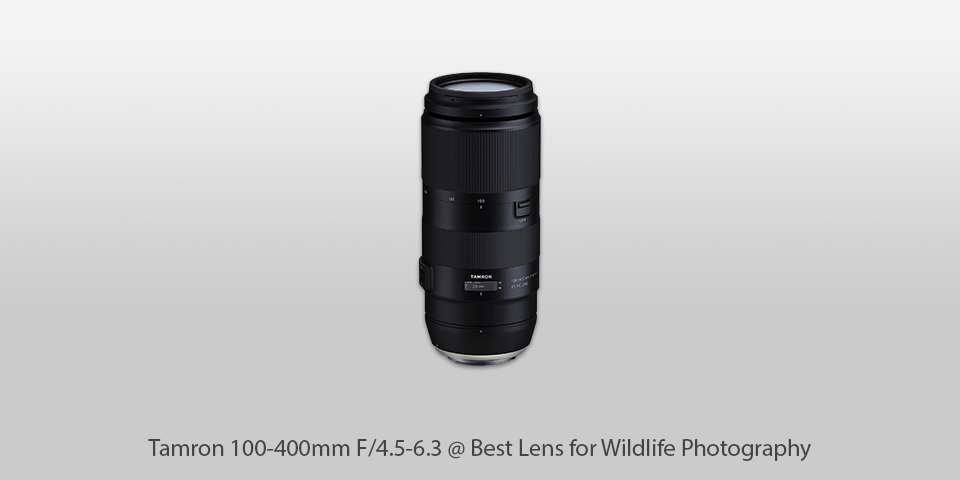
Mount: EF | Diaphragm blades: 9 | Autofocus: yes | Min focus distance: 1.5m | Max magnification: 0.28x | Filter thread: 67mm | Dimensions (WxL): 86.2 x 199 mm | Weight: 1135 g
⊕ Weather-proof
⊕ Good bokeh quality
⊕ Nice warranty
⊖ Tripod collar not included
⊖ Flare resistance is good but not perfect
The Tamron 100-400mm f/4.5-6.3 is the best lens for wildlife photography in this price category. It gives a good reach and nice image quality thanks to the USD focus system, which has tracking ability similar to the first-party competitors. This lens doesn’t have many compromises, so we strongly recommend you to consider it for wildlife shooting.
| Image | Name | Features | |
|---|---|---|---|
 |
Canon 100-400mm f/4.5-5.6 II
Our Choice |
CHECK PRICE → | |
 |
Nikon 200-500mm f/5.6
Zoom |
CHECK PRICE → | |
 |
Sigma 150-600mm f/5-6.3
Budget |
CHECK PRICE → |

If you are looking for the best lens for wildlife photography, you should consider the following important features:
You need a lens, which can take photos from a long distance. A lens for nature photography needs to be 200mm minimum. If you are planning to make close-ups and photographs of birds, opt for a 400mm model or more.
Quick and quiet autofocus is a must for wildlife photography. Even in the low light, you need a lens capable of detecting an animal and focusing on its features, while it will be moving around. We recommend you to choose AF systems with optimized image stabilization, a good glass, and low f-number. These features will enhance the AF system.
If you want to take great shots even in insufficient light, you need to use a wide-open aperture. A good lens for outdoor photography should have an aperture of f/5 or less. F/2.5 will be perfect.

The camera lenses for nature photography have to be compact and lightweight, as the photographers do a lot of hiking with their cameras. A 300mm lens is small and portable. Though, if you want detailed pictures, opt for a bigger lens. Try to find a model, which will be a good combination of super zoom and small weight.
Good wildlife photo lenses have a focal length of 300mm minimum. Experienced photographers consider 500mm the best focal length.
Yes. This is the minimum for this type of optics.
Seasoned shooters choose the Canon EF 200-400mm f/4L IS USM and the Nikon AF-S FX NIKKOR 500mm lens.
If you are a beginner and you are choosing your first wildlife telephoto lens, a 200mm lens will be enough. Most professionals recommend using 300mm as a minimum.

 Rating
Rating